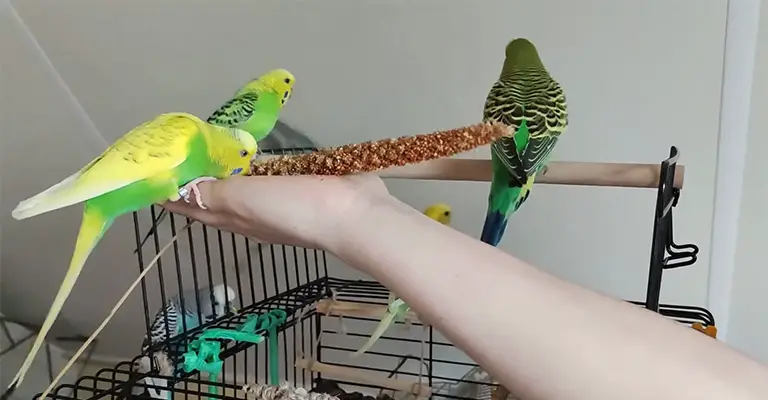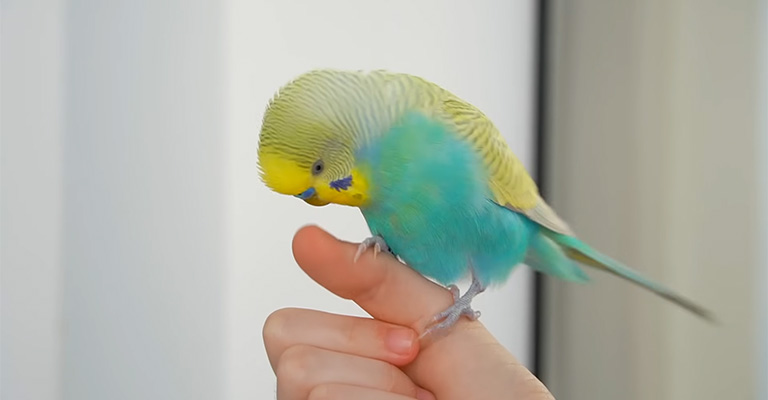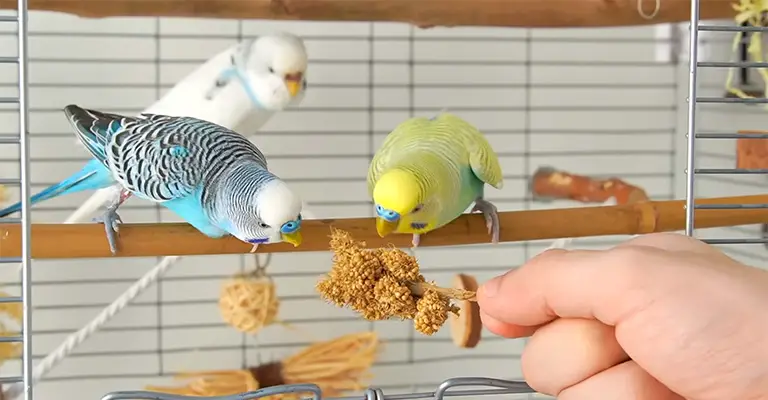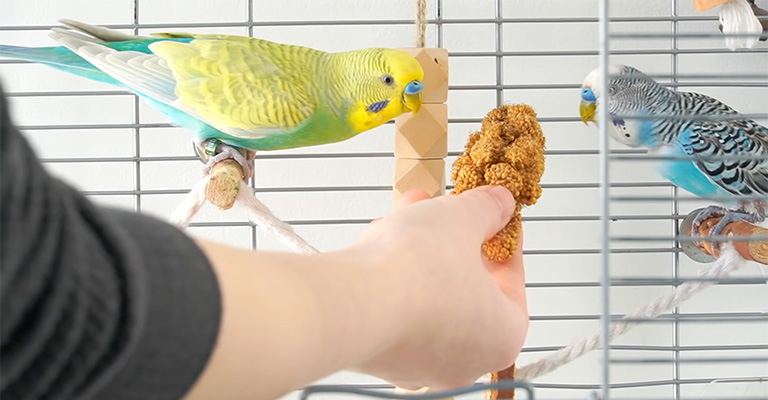Parakeets, also known as budgerigars, are delightful and intelligent birds that can make wonderful companions.
Building a strong bond with your parakeet can bring numerous benefits to both you and your feathered friend. Indeed, many beginners look forward to a way to know how to make a better bond with a parakeet.
In this article, we will explore the advantages of bonding with a parakeet, including the sense of security it provides for the bird, the joy and fulfillment it brings to the owner, and the overall positive impact on the bird’s well-being.

Parakeet’s Behavior to Make a Bond with Human
One of the first behaviors to observe in your parakeet is preening. Preening is a natural grooming behavior where the bird cleans and maintains its feathers.
When your parakeet is relaxed and content, it will often engage in preening. Take note of how frequently your bird preens and whether it focuses on specific areas of its body. This behavior indicates a sense of comfort and well-being.
Recognizing Fluffing Up
Fluffing up is another behavior commonly exhibited by parakeets. When a parakeet fluffs up its feathers, it may be an indication of feeling cold or stressed.
Pay attention to the context in which your bird fluffs up. If it happens frequently or in response to specific situations, it may be a sign that your parakeet is experiencing discomfort or anxiety.
Understanding Vocalizations
Parakeets use vocalizations to communicate their mood and intentions. Chirping, whistling, and singing are signs of a happy and content parakeet.
On the other hand, squawking or excessive screeching can indicate agitation or distress. By paying attention to the different vocalizations and their accompanying behaviors, you can gain insights into your parakeet’s emotional state.
Interpreting Body Language

Body language plays a significant role in understanding parakeet behavior. When your bird feels relaxed and comfortable, its feathers will lie flat against its body.
Conversely, a stressed or threatened parakeet may puff up its feathers or spread its wings wide. By observing your bird’s body language, you can determine its level of comfort and adapt your interactions accordingly.
Creating a Safe Environment
Providing a safe and comfortable environment is essential for your parakeet’s well-being. Ensure that the cage is spacious enough for your bird to move around freely, with multiple perches and toys for enrichment.
Place the cage in a quiet area of your home, away from loud noises and potential stressors. Maintaining a consistent schedule for feeding, playtime, and sleep will help your parakeet feel secure and establish a sense of routine.
Building Trust and Bonding
Building trust and bonding with your parakeet takes time and patience. Start by spending quality time near your bird’s cage, talking softly, and offering treats or favorite foods.
Gradually introduce your hand into the cage, allowing your parakeet to become comfortable with your presence. Through positive reinforcement, such as rewarding your bird for calm behavior, you can foster trust and deepen your bond over time.
How to Build Trust with a Parakeet

There are a few tips that can help you build a better bond with your parakeet. Here are all the tips right below.
Daily Interaction and Presence
Consistent daily interaction and spending time near your parakeet’s cage are key to building trust. Talk to your bird in a calm and soothing voice, allowing them to become familiar with your presence. Be patient and give them time to adjust to your company.
Offering Treats and Food
Offering treats and food from your hand is an effective way to build trust. Start by offering small, desirable treats, such as millet or a favorite fruit, from your open palm.
Allow your parakeet to approach and take the treatment at their own pace. Gradually increase the size of the treats as they become more comfortable.
Playtime and Positive Interactions
Engage in interactive playtime with your parakeet to build trust and strengthen your bond. Use toys, such as bells or puzzle feeders, to stimulate their curiosity and provide enrichment. Encourage their participation and offer praise or treats when they engage in positive behaviors.
Positive Reinforcement Training

Positive reinforcement training can help build trust and establish a deeper bond with your parakeet.
Teach simple commands, such as “step up” or “come here,” using rewards and praise. Use a gentle and patient approach, rewarding desired behaviors with treats or verbal affirmation.
Respect Personal Space and Limits
Respecting your parakeet’s personal space and individual limits is crucial for building trust. Pay attention to their body language and signals.
If your bird shows signs of stress or discomfort, such as backing away or flapping its wings, give them space and try again later. Pushing boundaries can damage the trust you’ve built.
Avoid Negative or Aggressive Training Methods
Negative or aggressive training methods can harm the bond between you and your parakeet. Avoid any form of physical punishment, such as hitting or shaking the bird.
Similarly, avoid using loud, harsh tones of voice. Instead, focus on positive reinforcement, patience, and consistency.
Be Patient and Respectful
Building trust takes time and patience. Every parakeet is unique, and it may take longer for some birds to fully trust and bond with their owners.
Respect your parakeet’s pace and boundaries, and always approach interactions with gentleness and kindness.
Enhancing the Bond

Enhancing the bond with your parakeet is an ongoing process that requires patience and consistency. Here are some tips to help enhance the bond between you and your parakeet.
Encourage Play and Interaction With Toys
Provide your parakeet with a variety of toys, such as swings, ladders, and bells, to keep them mentally and physically stimulated.
Rotate the toys regularly to keep things interesting for your bird. Additionally, you can interact with your bird by playing with the toys with them.
Provide Mental and Physical Stimulation
Parakeets are highly active birds and need plenty of mental and physical stimulation. Provide them with opportunities for exercise by placing their cage in a room where they can fly and by providing a play gym for them to climb. Additionally, consider providing interactive toys that challenge their problem-solving skills.
Encourage Talking and Singing
Parakeets are known for their ability to talk and sing. Encourage your bird to talk by talking to them regularly and repeating specific words or phrases. Additionally, play music or nature sounds to encourage singing.
Bonding With Multiple Parakeets
If you have multiple parakeets, it’s essential to spend time with each bird individually. This will help them bond with you individually and prevent them from becoming overly attached to each other.
Additionally, make sure to provide each bird with its own toys and perches to prevent competition and territorial behavior.
FAQs
The bonding process can vary depending on the individual bird and the owner’s approach. Some birds may bond quickly, while others may take longer. It’s important to be patient and consistent in your interactions with your bird and to avoid any negative or aggressive training methods.
A bond can be formed over time through daily interaction, positive reinforcement, and providing a safe and comfortable environment for your parakeet.
Yes, a parakeet can bond with multiple people. However, it’s essential to remember that bonding with a parakeet takes time and consistency.
By spending time with your bird, offering treats and food from your hand, using positive reinforcement training, and providing a safe and comfortable environment, you can build a strong bond with your parakeet.
Parakeets are social birds and may bond with other birds or animals. However, it’s essential to remember that bonding with a parakeet takes time and consistency.
It is also important to note that introducing other birds or animals can be stressful for the parakeet and it’s important to monitor the interactions and be aware of potential issues.
Some parakeets may be more independent and may not bond as closely with their owners as others. Additionally, certain factors such as past experiences or genetics can also affect a parakeet’s ability to bond.
It’s essential to remember that bonding with a parakeet takes time and consistency. And be sure to provide them with a comfortable and safe environment.
Yes, a parakeet can bond with its owner even if it is kept in a cage most of the time. It’s important to spend time interacting with your bird, offering treats and food from your hand, using positive reinforcement training, and providing a safe and comfortable environment.
Additionally, providing plenty of toys and opportunities for exercise can help keep your parakeet mentally and physically stimulated.
Conclusion
Bonding with a parakeet is a rewarding and fulfilling experience for both the bird and the owner. By investing time, patience, and consistency, you can build trust, understanding, and a strong bond with your parakeet.
This bond provides a sense of security for the bird, reduces stress and anxiety, and promotes a happy and healthy life. For the owner, a bonded parakeet brings joy, companionship, and a deeper connection.
So, take the time to understand your parakeet, create a safe and comfortable environment, and enjoy the wonderful journey of bonding with your feathered friend. Thank you for your time.